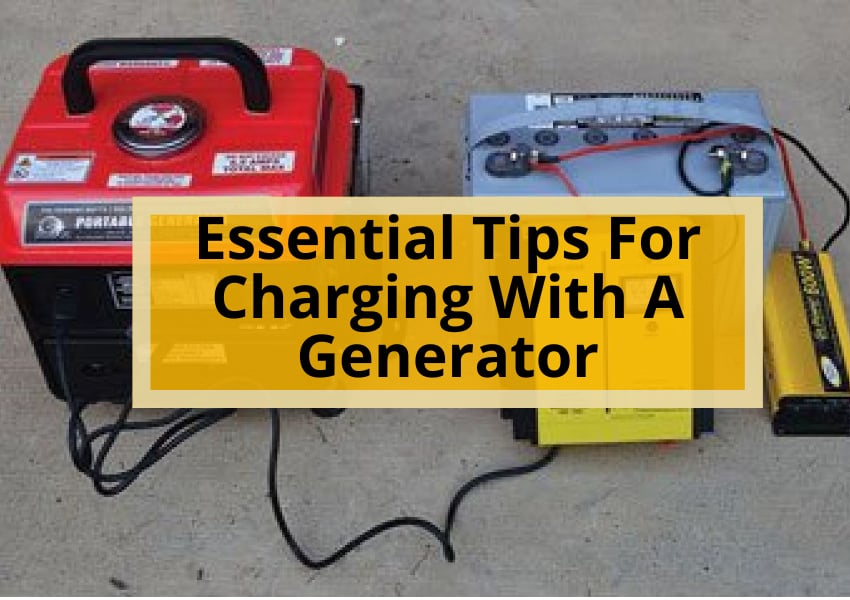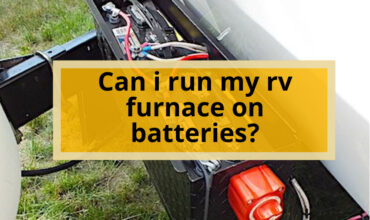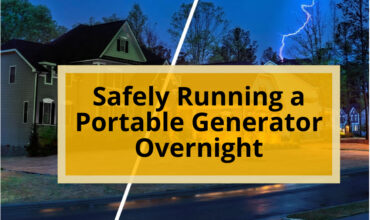Did you know that charging an RV battery with a generator can be slow and put a strain on the generator? In fact, it is recommended to use a smart charger plugged into a home’s electricity or an RV park’s shore power for a faster and more efficient charge.
However, if you find yourself in a situation where using a generator is the only option, there are important steps to follow to ensure a successful charge. This article will provide essential tips for charging your RV battery with a generator, including safety precautions and alternative methods to consider. By following these steps, you can effectively power up your RV battery and avoid any potential hazards.
So, let’s dive in and explore the best practices for charging your RV battery with a generator.

Charging Methods
One of the recommended charging methods for RV batteries is using a smart charger plugged into a home’s electricity or an RV park’s shore power, as generator charging is slow and taxing on the generator. This method ensures a more efficient and reliable charge for the battery.
However, if using a generator is the only available option, there are a few steps to follow. Firstly, ensure that the generator is fully charged and in good working condition. It is also important to check the battery connections for any signs of corrosion and ensure that the electrolyte levels are sufficient.
Before charging, it is advisable to turn off all lights and appliances to minimize power consumption. Finally, plug the generator into the battery and allow it to charge. It is important to prioritize safety by inspecting wires and connections, cleaning any corroded terminals, and ensuring correct polarity.
Safety Steps
To ensure safe charging of an RV battery with a generator, it is important to inspect the wires and connections, clean any corroded terminals, and ensure the correct polarity. Safety steps should always be followed to prevent any accidents or damage to the battery. Here are five essential safety steps to consider:
- Inspect wires and connections: Carefully examine the wires and connections for any signs of damage or loose connections. This will help prevent any potential electrical hazards.
- Clean corroded terminals: Over time, battery terminals can become corroded, which can impede the charging ability. Cleaning the terminals with a mixture of baking soda and water using an old toothbrush can help improve the connection.
- Ensure correct polarity: Double-check that the positive and negative terminals are correctly connected. Reversing the polarity can cause damage to the battery and other electrical components.
- Use proper tools and equipment: Always use the appropriate tools and equipment when working with the battery and generator. This includes using gloves, safety glasses, and insulated tools to minimize the risk of injury.
- Follow manufacturer’s instructions: Read and follow the manufacturer’s instructions for both the generator and battery charger to ensure safe and proper operation.
By following these safety steps, RV owners can ensure a safe and efficient charging process for their batteries, allowing for a worry-free traveling experience.
also read : Power Up Your Camping Adventures
Alternative Methods
An alternative method for charging an RV battery involves the use of solar panels or wind generators. Solar panels are a popular choice as they can charge the battery while on the move. However, it is important to note that it may take more than a day to fully recharge a dead battery using solar panels alone.
On the other hand, wind generators can generate more charge depending on the wind speed. It is worth mentioning that wind generators have a maximum wind speed rating, and caution should be exercised when attaching them while driving.
It is important for RV owners to consider these alternative methods as they can minimize the drain on the battery and provide an additional source of power.
Importance of Following Steps
It is crucial to adhere to the recommended steps for charging an RV battery to ensure safe and effective charging. Following these steps is essential for the well-being of both the battery and the generator.
By fully charging the generator and checking battery connections for corrosion, one can prevent any potential issues that may arise during the charging process.
Additionally, checking the electrolyte levels and turning off lights and appliances can help optimize the charging efficiency.
Furthermore, it is important to inspect wires and connections for any damages and clean corroded terminals to ensure a proper flow of electricity.
By following these steps, RV owners can safely charge their batteries and avoid any potential damage or hazards.
Additional Information
A small turbine, available in hardware and auto parts stores, can generate more charge than a solar panel depending on wind speed. This alternative charging method is particularly useful for RV owners who want to maximize their battery charging capabilities. However, it is important to exercise caution when using a wind generator.
Here are some additional points to consider:
- Turbine attachment: Ensure that the turbine is properly attached to your RV. Avoid attaching it while driving as this can result in low battery power and potential damage to the turbine.
- Maximum wind speed rating: Be aware of the maximum wind speed rating for your wind generator. Exceeding this rating can cause damage to the generator and may pose safety risks.
- Cleaning battery terminals: Over time, battery terminals can experience corrosion, which can impede the charging ability. Cleaning the terminals with a mixture of baking soda and water, using an old toothbrush, and applying petroleum jelly can help prevent future corrosion.
By following these additional tips, RV owners can effectively utilize a small turbine to generate more charge for their batteries, ensuring a reliable power source during their travels.
Frequently Asked Questions
Can I charge my RV battery with a generator while driving?
Charging an RV battery with a generator while driving is not recommended. It can be dangerous and may result in a low battery and damage to the generator. It is safer to charge the battery using alternative methods such as smart chargers or solar panels.
Is it necessary to check the electrolyte levels of the battery before charging with a generator?
Checking the electrolyte levels of the battery before charging with a generator is necessary to ensure proper functioning and prevent damage. This step helps maintain the battery’s performance and prolong its lifespan.
Can I use a regular 12 Volt battery charger to charge my RV battery using shore power?
Yes, a regular 12 volt battery charger can be used to charge an RV battery using shore power. It is recommended to use a smart charger to prevent overcharging and damage to the battery.
How long does it take for solar panels to fully recharge a dead RV battery?
The time it takes for solar panels to fully recharge a dead RV battery can vary depending on various factors such as the size of the solar panels, the amount of sunlight available, and the capacity of the battery. It may take more than a day to fully recharge a dead battery.
Can I attach a wind generator to my RV while driving to generate additional charge?
Attaching a wind generator to an RV while driving to generate additional charge is not recommended. This can result in a low battery and damage to the generator. It is important to follow recommended charging methods for safety and optimal performance.






